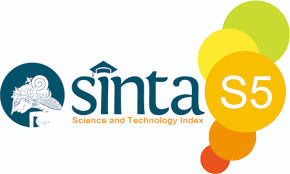Marketing Strategic for Hydroponic Vegetable Product to Improve Marketing Performance Base on Digital Technology
DOI:
https://doi.org/10.34010/injuratech.v4i1.14479Keywords:
Marketing strategic, Vegetable, Hydroponic, Digital technology, Marketing performanceAbstract
Agriculture is one of the sectors that has been the backbone of human civilization since the beginning, undergoing major transformation along with technological. The hydroponic vegetable market continues to grow along with increasing demand for healthy and sustainable agricultural products. In this digital era, marketing strategies based on digital technology are the key to increasing visibility and sales of hydroponic vegetable products. The purpose of this study is to investigate different digital marketing tactics that may be used to enhance the marketing effectiveness of hydroponically grown vegetables. By examining digital marketing techniques like social media marketing and the use of e-commerce platforms, this research identifies effective ways to strengthen the market position of hydroponic vegetable products in the digital era. The study also highlights the important role digital technology plays in changing the way manufacturers interact with consumers, measure marketing performance, and develop long-term relationships with customers. It is believed that the research's conclusions would give hydroponic vegetable growers insightful information and marketing practitioners in optimizing their marketing strategies in this increasingly digital market
References
[2] Al Hakim, R. R., Pangestu, A., Hidayah, H. A., Faizah, S., & Nugraha, D. (2022, October). Pemanfaatan Teknologi Iot Untuk Pertanian Berkelanjutan (IoT Technology For Sustainable Agriculture). In Prosiding Seminar Nasional Inovasi Teknologi Pertanian Berkelanjutan (INOPTAN) (Vol. 1, No. 1, pp. 1-9).
[3] Megantoro, P., & Ma’arif, A. (2020, October). Nutrient film technique for automatic hydroponic system based on arduino. In 2020 2nd International Conference on Industrial Electrical and Electronics (ICIEE) (pp. 84-86). IEEE.
[4] Rozie, F., Syarif, I., Al Rasyid, M. U. H., & Satriyanto, E. (2021). Sistem akuaponik untuk peternakan lele dan tanaman kangkung hidroponik berbasis IOT dan sistem inferensi fuzzy. Jurnal Teknologi Informasi Dan Ilmu Komputer, 8(1), 157.
[5] Setiawan, A. (2019). Buku Pintar Hidroponik. Laksana.
[6] Sutarni, S., Irawati, L., Unteawati, B., & Yolandika, C. (2018). Proses Pengambilan Keputusan Pembelian Sayuran Hidroponik Di Kota Bandar Lampung. Journal of Food System and Agribusiness.
[7] Mufida, E., Anwar, R. S., Khodir, R. A., & Rosmawati, I. P. (2020). Perancangan alat pengontrol ph air untuk tanaman hidroponik berbasis arduino uno. INSANTEK-Jurnal Inovasi dan Sains Teknik Elektro, 1(1), 13-19.
[8] Dwisakti, V., Santoso, A., & Hartono, S. (2023). Analisis Strategi Harga Dan Inovasi Produk Terhadap Keunggulan Bersaing Usaha Sayuran Hidroponik Di Kabupaten Ponorogo. JIM: Jurnal Ilmiah Mahasiswa Pendidikan Sejarah, 8(3), 2552-2560.
[9] Wilis, R. A., & Augustina, R. A. (2022). Influencer & Blogger Sebagai Strategi Pemasaran Era Digital. Jurnal Ilmu Siber (JIS), 1(3), 101-116.
[10] Wilis, R. A., & Nurwulandari, A. (2020). The effect of E-Service Quality, E-Trust, Price and Brand Image Towards E-Satisfaction and Its Impact on E-Loyalty of Traveloka's Customer. Jurnal Ilmiah Manajemen, Ekonomi, & Akuntansi (MEA), 4(3), 1061-1099.
[11] Rahmadhani, L. E., Widuri, L. I., & Dewanti, P. (2020). Kualitas mutu sayur kasepak (kangkung, selada, dan pakcoy) dengan sistem budidaya akuaponik dan hidroponik. Jurnal Agroteknologi, 14(01), 33-43.
[12] Yuliardi, O., Zufria, I., & Irawan, M. D. (2023). Sistem Pakar Mendiagnosis Nutrisi Tanaman Hidroponik Menggunakan Metode Dempster Shafer. Jurnal Sistem Informasi Triguna Dharma (JURSI TGD), 2(3), 425-432.
[13] Palande, V., Zaheer, A., & George, K. (2018). Fully automated hydroponic system for indoor plant growth. Procedia Computer Science, 129, 482-488.
[14] Madusari, S., Astutik, D., & Sutopo, A. (2020). Inisiasi Teknologi Hidroponik Guna Mewujudkan Ketahanan Pangan Masyarakat Pesantren. Jurnal Pengabdian Masyarakat Teknik, 2(2), 45-52.
[15] Fazalika, F. D., Miftah, H., & Yoesdiarti, A. (2023). Evaluation Of Marketing Risk At The Producer Level Of Hydroponic Products In Bogor City. In Proceeding Djuanda International Conference (pp. 252-260).
[16] Roidah, I. S. (2014). Pemanfaatan lahan dengan menggunakan sistem hidroponik. Jurnal Bonorowo, 1(2), 43-49.
[17] Julianto. 2021. “Hidoponik: Cocok Tanam di Pekarangan Sempit”. Elex Media Komputindo
[18] Iis, M., Triyono, S., & Tusi, A. (2015). Pengaruh media tanam granul dari tanah liat terhadap pertumbuhan sayuran hidroponik sistem sumbu. Jurnal teknik pertanian Lampung, 4(2), 143-145.
[19] Asmarantaka, R. W. (2012). Pemasaran agribisnis (agrimarketing).
[20] D. Sunyoto. “Perilaku Konsumen dan Pasar”. Yogyakarta: CAPS. 2015.
[21] B. R. T. Putri. “Manajemen Pemasaran”. Denpasar: Universitas Udayana Press. 2017.
[22] Shinta, A., & MP, I. (2011). Manajemen Pemasaran. Malang.
[23] S. Assauri. “Manajemen Pemasaan”. Jakarta: Rajawali Pers. 2013.
[24] B. Swasta. “Mnajemen Pemasaran Modern”. Yogyakarta: 2008.











